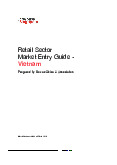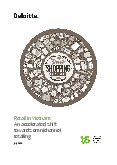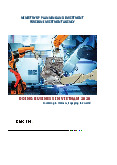




Preview text:
CHAPTER 9: CASH FLOW PROJECTION
I. Identifying Cash Flows:
1. Cash flows versus Accounting Income and Incremental cash flows.
1.1.1. Cash flows versus Accounting Income:
To calculate NPV, we discount cash flows, not profit.
⇛ The income statement do not track cash flow as well as can’t reflect how the
performance of the company is.
1.1.2. Incremental cash flows:
Step to calculate the Incremental cash flows: In
Cash flows with project – Cash flows without project = Incremental cash flows
that: - Cash flows with project: Forecast the firm’s cash flows if implementing the project.
- Cash flows without project: Forecast the firm’s cash flows if refusing the project.
- Incremental cash flows: Take the differences. This is the extra (incremental) cash flows.
Some tricks to solve as applying the Incremental cash flows:
a. Include all indirect effects.
b. Include Opportunity Cost (OC).
Opportunity costs: benefit or cash flow forgone as a result of an action. It’s
treated as the cash generated from the project. It’s a relevant cash flow for project evaluation. c. Forget Sunk Cost.
It’s a cost that has already been occurred and can’t be recovered. It remains
the same whether accepting the project or not. Do not affect the project’s NPV.
d. Recognize the Investment in Working Capital (WC).
Investments in WC just like in plant and equipment, result in cash outflows.
We focus on change in working capital (WCt+1 – WCt) during life of project.
WC maybe recovered at the end of the project (cash inflows).
Net working capital = Current assets – Current liabilities
In that: - Current assets = cash + account receivable + inventories.
- Current liabilities = account payable + accruals. 2. Inflation. INFLATION RULE:
• Be consistent in how you handle inflation.
• Use nominal interest rates to discount nominal cash flows.
• Use real interest rates to discount real cash flows.
• You will get the same results, whether you use nominal or real figures.
1 + real interest rate =
3. Separation of Investment & Financing Decisions.
- When valuing a project, ignore how the project is financed. We should view project
as if it were all equity-financed.
- Ignore proceeds from debt issue, and interest and principal payments on the debt.
- Separate analysis of investment decision from that of financing decision.
II. Calculating Cash Flows:
1. Calculating cash flows.
Total CF (cash flow) = CF from investment included: in fixed assets, from
investment in working capital and from operations.
Cash flow in fixed assets: In
CF = cash to acquire fixed assets + cash when disinvest/ sell these assets that,
the cash when disinvest/ sell these assets is calculated by:
= Proceeds of selling assets - - ( Proceeds -
- Book value at the time of selling) * * Tax rate
Example: The taxi firm forecasts revenues of 160.000 a year. Variable costs will
be $50.000 and rental costs for the shop are $32.000 a year. Depreciation on the repair tools
will be $10.000. Prepare an income statement. The tax rate is 20%. Revenues $160000 - Variable costs $50000 - Rental costs $32000 - Depreciation $10000 = Profit before tax
160000 – (50000+32000+10000) = $68000 - Tax @35% (68000*20%) = $13600 = Net profit 68000 – 13600 = $54400
Cash flow in working capital:
CF = - change in working capital
= - (Working capitalt+1 - Working capitalt)
= cash + account receivable + inventory – accounts payable
Example: Praha Company showed the following components of working capital last year: Begining End of year Accounts receivable $25000 $23000 Inventory 13000 12500 Accounts payable 14000 16500
a. What is net working capital during the year?
b. If sales were $35000 and costs were $24000, what was cash flow for the year ? Ignore taxes. Solutions:
a. Begin = 25000 + 13000 – 14000 = $24000.
End = 23000 + 12500 – 16500 =$19000.
NWC = 19000 – 24000 = $-5000.
So, the next working capital is $-5000. b. Change in WC:
= The current WC – The previous WC
= [(23000+12500)-16500] – [(25000+13000)-14000] = 19000-24000 = $-5000
Cash flow= revenues – costs – change in WC
= 35000 – 24000 – (-5000) = $16000
=> Cash flow for the year is $16000.
Cash flows from operations:
There’re two methods to calculate cash flow: - DIRECT METHOD:
CF = cash revenues – cash expenses – tax paid - INDIRECT METHOD:
CF = profit after tax + depreciation
= (revenues – expenses) * (1 – tax rate) + (depreciation* tax rate) 2. Depreciation. o
Straight-line De = the original price x o Reducing balance.
o Accelerated depreciation (MACRS).
o MACRS increase present value of tax shield.
o Depreciation is NOT a cash flow.
o Depreciation reduces taxes ⇒ depreciation tax shield.




